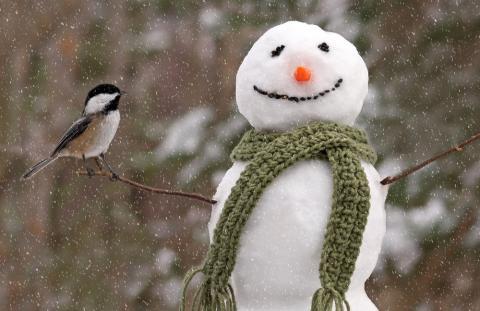
Want to welcome Blue Jays, Cardinals, and other stunning birds to your backyard? The better question is, who doesn't? Birds can bring such wonderful joy to a backyard, especially in the dead of winter, or late fall. The best part is, all the food you need to attract them can be found right in your local supermarket (and won't break the bank). Plus, feeding birds in the colder months helps them store and conserve energy for when they really need it (staying warm and avoiding predators). Here are the foods that will keep them coming back for more.
Northern Cardinal

When it's the dead of winter, Cardinals are a true joy to see. They are that bright pop of color that everyone craves in a snowy wonderland. Did you know that the bright red cardinals are the males and the brownish red ones are the females? The reason the female is brown is because she is the one that tends to the nest most, so she must be better camouflaged. If you would like to see these beautiful birds in your yard, leave sunflower seeds, raisins, bananas, and crushed peanuts out for them. They regularly come to bird feeders, so it shouldn't take much to attract them; however, they do favor sunflower seeds.
Purple Finch

Funny name for a bird who's more rose colored than purple. Either way, this stunning little guy is not as common to see as most of the birds on this list. Their main competitors for food are House Sparrows and House Finches, which can bully them away from bird feeders. If you want to see these tiny little creatures around your backyard, try leaving out some sunflower seeds, raspberries, blackberries, and crushed peanuts. The Purple Finch mainly eats seeds in the winter, so make sure to leave an abundance of crushed peanuts and sunflower seeds out for them when it gets cold.
Mourning Dove

Doves are often depicted as white, angelic creatures in the Catholic faith, but in reality, they are not always white. The Mourning Dove is instead a light brown color and extremely common in suburban areas. They're pretty hard to miss, and that's because they're prolific breeders: They may raise up to six broods per year, which means these doves don't exactly practice abstinence. That said, they tend to mate for life and both the male and female tend for their young equally. If you want to attract these affectionate lovebirds to your home, make sure there are plenty of bread crumbs, fruit, sunflower seeds, and cracked corn around. They tend to like feeding from the ground, so don't be surprised if you see them feasting right under your elevated bird feeder!
Woodpeckers

Ever hear the sound of a woodpecker going to town on some bark? They're not really eating the wood: The pecking is typically used as a method of communication. The drumming you hear is meant to advertise their territory, attract a mate, or even ward off intruders. No wood is eaten during this process, but woodpeckers will sometimes do this to lure bugs out of the bark they're drumming. Since there are so many different kinds of woodpeckers, you never know which you'll attract to your yard. However, most woodpeckers love a good mix of sunflower seeds, apples, crushed peanuts, oranges, suet, and melon seeds. If you lay these out, at least one species of woodpecker will be delighted to make your acquaintance.
Black-Capped Chickadee

Personally, I adore the Black-Capped Chickadee. I've only seen it once or twice in the wild, but each time I did it was super adorable with its puffy little body and small stature. That said, the Black-Capped Chickadee is a fairly common bird and not endangered at all (thankfully none of the birds on this list are) -- I just haven't had much luck spotting it. Maybe that's because it's most commonly spotted in open woods and the forest edge (I don't really go into the forests in my area). Thankfully though, they will live in suburban areas, as long as nest sites are available and food supply is readily available. Ironically enough, Black-Capped Chickadees really like sunflower seeds, shelled or crushed peanuts, and get this – pie crust. Since it's fall, and everyone's making apple/pumpkin pies, this is kind of convenient (albeit funny). So remember: The next time you're eating some pie, don't finish it all! Leave some for the Black-Capped Chickadees.
Blue Jay

Blue Jays are just as striking to see in the winter as a cardinal, if you ask me. Their colors resemble jewels and gems, shimmering and gleaming against the dead winter's trees. Blue Jays are fairly common and are well adapted for suburban life. They love to call out to one another with their distinct jay! jay! tweets, but that's far from the only sound these birds make. Believe it or not, they have a knack for imitating other animals (similarly to their cousin, the crow), and love to impersonate Red-shouldered Hawks. If you'd like to attract this intelligently beautiful bird to your home, leave out some cracked corn, sunflower seeds, and shelled or crushed peanuts for them. They'll be sure to thank you (and spread the word to other Blue Jays) with their unforgettable squawks.








